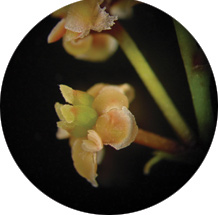 |
Botanists
Help Create "Supertree"
downloadable
pdf
A
group of scientists has created the first comprehensive evolutionary
reconstruction of the many families of flowering plants, an
achievement that could aid in the search for plant-based cures
for diseases and improve agricultural crops.

The group, which includes two University of Florida botanists,
published its results in the online edition of the Proceedings
of the National Academy of Sciences.
UF botany Professor Doug Soltis said flowering plants are
the largest group of plants, comprising at least 250,000 species,
with the oldest originating at least 130 million years ago.
Encompassing nearly all grain and vegetable crops, they are
also by far the most nutritionally and economically important
plants.
Specialists in flowering plants, known scientifically as angiosperms,
have created hundreds of “phylogenetic trees”
— evolutionary lineages outlining which species predate
and give rise to others — for specific groups.
Until now, however, no one had merged them all into one “supertree”
mapping out the entire history of flowering plants.
“This is the first crack at it,” said Soltis,
who coauthored the paper with Pamela Soltis, a curator at
UF’s Florida Museum of Natural History, and four British
authors. “Now, we can take this and keep building on
it and building on it. If we get enough data, eventually,
years down the road, we can get all these 250,000 species
of angiosperms into one (evolutionary) tree.”
From a scientific perspective, the feat is important partly
because it appears to help settle a long-standing debate about
how flowering plants diversified into the extraordinarily
varied forms they represent today, said Pam Soltis, who also
is Doug Soltis’ wife. Both researchers are members of
the UF Genetics Institute.
Biologist Charles Darwin first recognized that flowering plants
underwent a rapid period of diversification more than 100
million years ago.
Since then, scientists have debated whether that and similar
diversification events resulted from key innovations in the
plants’ physiology or shape or rather from a series
of smaller, less obvious or significant changes. For example,
some have argued the appearance of the flower itself is a
key innovation that spurred the success of flowering plants,
while others have said the flower may represent several different
innovations.
Pam
Soltis said the supertree appears to come down on the side
of many different innovations versus few significant or key
innovations.
“When we look at those places within flowering plants
where diversification has been high, there’s nothing
obvious that jumps out at us as some big morphological innovation
at that point,” she said.
Doug Soltis said the supertree is also important because it
adds to a widespread effort to create similar trees for other
large groups of species. Eventually, the goal is to create
a comprehensive cross-species “tree of life,”
locking into place the evolutionary history and context of
all living organisms, he said. The UF supertree research was
funded in part by the National Science Foundation, which is
also supporting the “tree of life” effort.
From a more practical perspective, the flowering plant tree
may prove useful to both medical and agricultural scientists,
he added.
“If,
for example, you find that a
particular cancer-curing drug is in a particular plant, you
might want to ask, ‘Where else can I find that chemical?,’”
he said. “Because close relatives usually do similar
things, you would begin your search at that place in the tree.
“It’s also very useful if you are involved in
crop plants. You might want to ask, ‘What are the closest
wild relatives to crop plants?’ because you might go
to those plants to find a gene that would help you improve
disease resistance. We really can learn a lot by knowing how
different species are related.”
Doug Soltis said scientists build the trees using molecular
data from the gene sequences of different species of plants.
The Soltis’ contribution to the supertree project was
to gather and merge the many different trees using computer-driven
algorithms, or formulas, designed to merge large amounts of
molecular data.
“This is an interesting marriage of biology and math,”
Doug Soltis said. “The mathematicians have really set
the stage for supertrees.”
The other authors of the paper are scientists at the Silwood
Park Campus of the Imperial College London in Berkshire, England,
and the Royal Botanic Gardens in Kew, England.
Doug Soltis, dsoltis@ufl.edu
Pam Soltis, psoltis@flmnh.ufl.edu
by Aaron Hoover
|

